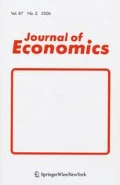Abstract
In a setting where agents must choose between two investments, Zhang (in RAND J Econ 28:188–205, 1997) proposed an equilibrium in which there is strategic delay. This equilibrium relied upon there being an information cascade. We shall demonstrate that an information cascade need not generally occur. It will only occur if and only if the cost of investing takes relatively extreme values. Taking this into account we derive a revised equilibrium that is still characterized by strategic delay.

Similar content being viewed by others
Notes
For reasons that will become clear as we proceed, it is not possible to have an information cascade where all other agents invest in a different project to the first mover.
Recall that \(\Pr (\omega ^{1})=\Pr (\omega ^{2})\).
To directly apply the results of Zhang would require that
$$\begin{aligned} \Pr (\omega |\theta _{1},q,\theta _{2},p)_{\theta _{1}=\theta _{2}}=\Pr (\omega |\theta _{1},q,\theta _{2},p)_{\theta _{1}\ne \theta _{2}}=\Pr (\omega |\theta _{1},q). \end{aligned}$$Basically this requires that only the agent with the most informative signal has any information about which investment option is profitable. A related idea was used by Scharfstein and Stein (1990). It seems, however, a somewhat un-intuitive and unsatisfactory solution in this instance.
Recall that Zhang assumes that \(G(c)=0.5c\) and so we derive an equilibrium for a ‘different’ \(G\) function.
Given that \(\tau ^{*}(p)\) must be positive we require that
$$\begin{aligned} \frac{E[c]-G(1)E[c|c<1]-2x(1-G(\overline{c}))}{2x-E[c]}>0 \end{aligned}$$for all \(x\in [\underline{p},\overline{p}]\). This imposes additional conditions on permissable probability distributions over cost.
Using
$$\begin{aligned} \int \frac{dx}{ax^{2}+bx+e}=\frac{1}{2\sqrt{b^{2}-ae}}\ln \left| \frac{ ax+b-\sqrt{b^{2}-ae}}{ax+b+\sqrt{b^{2}-ae}}\right| \end{aligned}$$if \(b^{2}>ae\).
References
Bikhchandani S, Hirshleifer D, Welch I (1998) Learning from the behavior of others: conformity fads, and informational cascades. J Econ Perspect 12:151–170
Chamley CP (2004a) Rational herds: economic models of social learning. Cambridge University Press, Cambridge
Chamley CP (2004b) Delays and equilibria with large and small information in social learning. Eur Econ Rev 48:477–501
Frisell L (2003) On the interplay of informational spillovers and payoff externalities. RAND J Econ 34:582–592
Gale D (1996) What have we learned from social learning? Eur Econ Rev 40:617–628
Scharfstein DS, Stein JC (1990) Herd behavior and investment. Am Econ Rev 80:465–479
Zhang J (1997) Strategic delay and the onset of investment cascades. RAND J Econ 28:188–205
Author information
Authors and Affiliations
Corresponding author
Additional information
I would like to thank two anonymous referees of this journal for their helpful comments on an earlier version of the paper. And I would also like to thank Anna Stepanova for help with solving example 2.
Rights and permissions
About this article
Cite this article
Cartwright, E. Strategic delay and information cascades. J Econ 114, 63–74 (2015). https://doi.org/10.1007/s00712-014-0393-5
Received:
Accepted:
Published:
Issue Date:
DOI: https://doi.org/10.1007/s00712-014-0393-5



